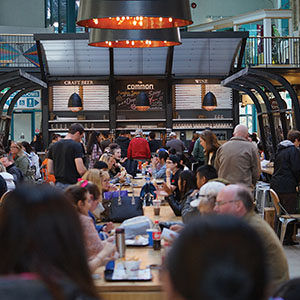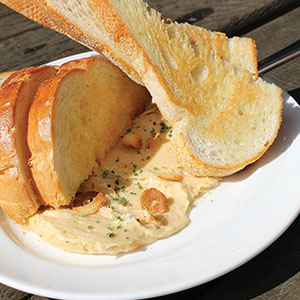Located in the heart of the Canadian prairie, Winnipeg had high hopes of being the Chicago of the North. In the early 1900s, Main Street was home to nearly 40 financial institutions, and the city’s train station was a scale model for New York’s Grand Central Terminal. WWI and financial turmoil intervened, and those plans never quite materialized. Today, the city is Canada’s seventh-largest, with a population of around 700,000. However, Winnipeg is home to a burgeoning food scene that is considered to be Canada’s most underrated—and cheese has played a large role in the culinary renaissance.

The Exchange District is the epicenter of Winnipeg’s vibrant dining scene. It was once the city’s warehouse district, with about 180 stone and brick warehouses and terracotta-clad buildings built between 1880 and 1920. Today, the trendy 22-block neighborhood is a National Historic Site and has stood in as a movie double for turn-of-the-century Chicago. Buildings that once housed commodity exchanges and wholesalers are now home to boutiques, galleries and restaurants.
Deer + Almond
One of the Exchange district restaurants at the vanguard of Winnipeg’s food scene is Deer + Almond, established by chef Mandel Hitzer in 2011.
Creative uses of cheese are woven throughout the menu of small plates, noodle bowls and sandwiches. The truffle fries are topped with salty shreds of Manchego, melted just enough to form a delicate lacework of cheese. A fried green tomato sandwich features Halloumi, and the spinach farfalle includes raw milk Manchego. The most inventive option on the dessert menu is the “Salt of the Earth,” a sweet and savory combination of beet ice cream, pickled blueberries, Feta, dried mushroom and cocoa.
Cordova Tapas & Wine

For a more classic take on small plates, visit Cordova Tapas & Wine, a European-style tapas bar with French, Spanish and Italian wines, Belgian and Spanish beers, and a cheese-heavy menu of small plates inspired by the cuisine of Spain and southwest France.
The eminently shareable cheese platter is the best way to sample the restaurant’s impressive cheese selection. There’s Gouda from Holland, Blue cheeses, plenty of selections from France and a range of cheeses from small Quebec cheesemakers.
Other cheese-focused dishes on the menu include an oven-baked Camembert topped with maple syrup, honey, rosemary and walnuts and served with a toasted baguette. The pan Catalan is like a Spanish version of grilled cheese: oven-toasted bread with cherry tomatoes, Manchego and Serrano ham.
Kevin’s Bistro
Another cheesy dining destination in the Exchange District is Kevin’s Bistro, a macaroni and cheese restaurant from the owners of Stella’s, a popular chain of cafés throughout Winnipeg. The restaurant is located in a narrow space nestled between two exterior brick walls and was a carriageway back in the Exchange District’s heyday. Co-owner Grant Anderson explains that while the space was intriguing, it was ill-suited to the Stella’s concept, since it couldn’t accommodate a hood or gas appliances. Instead, the owners decided to focus on elevating macaroni and cheese—a dish that can be prepared with induction burners and a ventless oven.
One of the most popular items on the menu of nearly a dozen macaroni and cheeses is the Canadiana. Egg noodles are coated in a bechamel sauce with Cheddar, Fontina and Gruyère and then combined with maple syrup and bacon, baked with Cheddar cheese, and garnished with Old Dutch salt and vinegar potato chips.
“People question the maple syrup, but cheese and maple actually work very well together,” says Anderson. “The saltiness of the cheese balances the maple.”
Anderson’s favorite dish on the menu is the Hops & Blue, which plays with a beer and cheese pairing. The dish includes Mozzarella, a Belgian wheat beer from local Torque Brewing, ground hops and caramelized onion and is finished with a Blue cheese gratin. The restaurant’s other macaroni and cheeses feature Havarti, smoked Gouda, Provolone, Jack cheese and even a cashew-based sauce for vegans.

The Forks
Winnipeg’s dining scene’s other hot spot is The Forks, the district at the confluence of the Red and Assiniboine Rivers. A traditional gathering place for First Nations peoples, the area later played a role in the fur industry and eventually became a railroad hub. Today, it’s home to The Forks Market, a recently renovated food hall with plenty of options for cheese lovers.
One of newest additions to The Forks Market is Passero, a contemporary Italian restaurant from chef and owner Scott Bagshaw (his other popular Winnipeg restaurants include Enoteca, a contemporary French restaurant, and Máquè, which serves contemporary Asian cuisine). “Cheese is an excellent way to add dimension to food,” Bagshaw says. “There are lots of vegetarians these days, and cheese can be used as a meat substitute.” He notes that smoked Cambozola, in particular, has an almost meat-like quality; at Passero, it’s used in a salad with salt-roasted beets, pistachios, blood orange, salsa verde and 15-year aged balsamic vinegar.
Dishes on the Passero menu are obviously heavy on Italian cheeses: Arancini with Fontina, Ricotta gnocchi served with wild mushrooms and Parmigiano Reggiano, roasted Brussels sprouts with bacon and Gorgonzola. However, fresh Mozzarella is sourced locally, and Bagshaw notes that Winnipeg is starting to produce good quality Burrata.
Bagshaw also operates Corto, an adjacent counter with a menu of grilled cheese sandwiches with Italian components. “We’re using really high-quality cheeses that you wouldn’t usually see in local sandwich shops, like cave-aged Gruyère and fresh Mozzarella,” he says. Sandwiches are cooked on a panini press that uses microwave and convection technology to toast sandwiches in four to five seconds, compared to two to three minutes for a standard panini press. This guarantees a crispy bread exterior with a satisfyingly melty cheese interior.
Another option in The Forks Markets for cheese-focused cuisine is pizza purveyor Red Ember Common. The restaurant features a stone oven imported from Naples, and the individually-sized pizzas cook at 750 degrees F in less than two minutes. The regular menu lineup tends toward pizzas topped with Mozzarella, but daily specials pair seasonal produce with unexpected cheeses like Blue cheese, Feta and goat Cheddar. For example, the “Crete-za” is topped with dill pesto, goat Cheddar, roasted garlic, spinach and pickled onions; the “Twist & Sprout” features crème fraiche, brussel sprouts, roasted garlic, pancetta and Blue cheese.

SMITH at the Inn
SMITH, located in the nearby Inn at the Forks, also focuses on local and seasonal Canadian ingredients. Small plates and appetizers include a toast topped with housemade Ricotta, a Canadian cheese board and a pounded cheese spread made with aged Cheddar. At brunch, the signature eggs are served atop hash browns with pulled pork and a maple smoked Cheddar gravy.
Since The Forks takes its name from the Red and Assiniboine Rivers, it’s fitting that one of the district’s most iconic restaurants is literally on the water. Perched halfway across a bridge spanning the Red River, Mon Ami Louis offers panoramic views and a menu of cheese-heavy, French-inspired cuisine. “This is one of those places where if you don’t have cheese, you can’t run the restaurant,” says chef de cuisine Chinnie Ramos. One of the most popular menu items is the deep-fried almond crusted Brie appetizer, garnished with caramelized apples and a raspberry coulis.
There are also tartes flambées, both traditional and riffs with goat cheese, Mozzarella and Cheddar. The poutine—probably Canada’s most famous cheesy dish—is made with duck fat fries and topped with brisket, red wine gravy, pickled red onion, horseradish cream and fresh curds.

Chaeban Ice Cream
For dessert, stop by Chaeban Ice Cream in the South Osborne neighborhood. Co-owner Joseph Chaeban is a second-generation cheesemaker who incorporates Ricotta and cottage cheese into his ice creams. Chaeban explains that solids need to be added to ice cream to prevent crystallization, and he uses all-natural ingredients, incoproating dairy products instead of artificial fillers; the Plain Jane vanilla ice cream is made with cottage cheese.
The milk for the ice cream is sourced from local dairies and pasteurized on-site, which allows Chaeban to add ingredients like strawberries or bananas prior to pasteurization to achieve a richer flavor. Each batch of ice cream takes three to four days to make, thanks to plenty of rest periods to maximize flavor. “It’s a lot like cheese where you have to age your product to really get your flavor out,” says Chaeban. “Just like cheese, the longer you age it, the better the taste is.”
Chaeban’s wife and shop co-owner Zainab Ali is instrumental in flavor development. “I take the science part…my wife will tell me what she wants to put inside,” he says. The shop’s signature flavor, Abir Al Sham, reflects the couple’s Arabic roots. The Ricotta-enriched ice cream is flavored with rose and orange blossom waters, pistachios and cashews, with orchid root powder as a binding agent.
“We want to be as unique as possible,” says Chaeban. “I have a really big passion for dairy—I know it’s something small, ice cream is easy to make, but it’s what you put inside that counts.”



